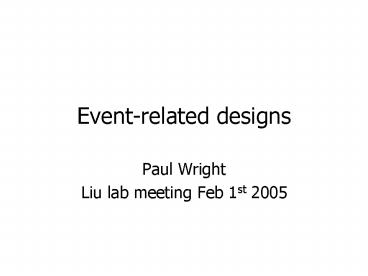Event-related designs - PowerPoint PPT Presentation
1 / 28
Title:
Event-related designs
Description:
Habituation. Anticipation. Need to randomize stimuli. Analyze trials by performance. Review ... Hemodynamic response (HDR) can be separated at 5s and 2s ITI ... – PowerPoint PPT presentation
Number of Views:22
Avg rating:3.0/5.0
Title: Event-related designs
1
Event-related designs
- Paul Wright
- Liu lab meeting Feb 1st 2005
2
Why use event designs?
- The alternative block design
- Habituation
- Anticipation
- Need to randomize stimuli
- Analyze trials by performance
3
Review
4
Trial timing
SOA Stimulus Onset Asynchrony
ISI Interstimulus interval
ITI Intertrial interval SOA
5
Dale and Buckner (1997)
- Key concept selective averaging
- Hemodynamic response (HDR) can be separated at 5s
and 2s ITI - Activation is robust at 2s ITI
- Fixed ITI
- Two trial types randomized
6
Dale and Buckner (1997)
- Selective averaging
- Signal is averaged relative to event start
- Event types averaged separately
- Activation covariation between
- Observed signal
- Normalized predicted HDR
7
Dale and Buckner (1997)
8
Dale and Buckner (1997)
9
Dale and Buckner (1997)
10
Dale and Buckner (1997)
- Caveats
- We did observe subtle departures from linearity
- results apply only to simple visual
stimulation - higher-order task trials may produce
non-linearity due to the underlying neural
activity
11
Dale and Buckner (1997)
- the BOLD fMRI responses add roughly linearly,
even when the trials are spaced as little as 2
sec apart.
12
Dale (1999)
- Simulated experiments
- Calculated estimation efficiency
- Ability to accurately calculate HDR
- Shorter ISI is better, if variable
- Not all random patterns are equal
13
Dale (1999)
14
Dale (1999)
- A significant improvement typically can be
achieved by generating a large number of
candidate experimental designs using a stochastic
process, and the selecting the one affording the
greatest estimator efficiency.
15
Soon et al. (2003)
- Used faces presented for 1.5 sec
- Single face or pair
- ITI either 3 sec or 6 sec
- Second face either the same or different
- The second face response was smaller
- With shorter ITI
- With identical faces
16
Soon et al. (2003)
17
Soon et al. (2003)
- Simulations
- Jittered 9 sec ITI (6, 9, or 12 sec)
- Jittered 6 sec ITI (3, 6, or 9 sec)
- 3 sec ITI with null trials (mean ITI 4.5 sec)
- Simulated 20 signal loss with 6 sec ITI, and 40
with 3 sec ITI - Detection power increases with ITI
18
Soon et al. (2003)
- Rapid designs suffer from both neuronal and
hemodynamic apaptation - Shorter ITI lowers power, but
- The higher variance is compensated by the
increase in power due to the larger number of
events. - Short ITI minimum 3 sec,average 4.5 - 6 sec
19
Serences (2004)
- Simulated experiments
- Compares event-related averaging with
deconvolution - Explains how jittering works
- exponential distributions have been shown to
yield more efficient experimental designs than
uniform ISI distributions
20
Serences (2004)
The critical constraint on solving any system of
linear equations is that there must be as many
unique equations as there are unknowns.
21
Serences (2004)
22
Serences (2004)
23
Serences (2004)
- Deconvolution is superior to event-related
averaging when stimuli are sequence dependant - Is Serences method the same as our GLM?
- When stimuli are random, both methods can
estimate the HDR
24
Summary
- What is the ideal ITI?
- Dale says as low as 2 sec
- Soon and Serences 3 sec
- How to jitter?
- random conditions (Dale)
- randomized ITI (Soon)
- null trials (Serences used exponential
distribution)
25
Summary
- How to analyze?
- Dale averaged events first, then fit to a curve
- Brainvoyager creates a predicted time course for
the entire experiment - Deconvolution and event-related averaging are
both acceptable if stimuli are not sequence
dependant (Serences) - How many trials?
- Numbers vary from minimum of 25 up to 60 per
condition
26
What now?
- Jessicas event-related face matching design
- Randomized conditions
- No jitter
- ITI 5 sec
27
What now?
- My go/no-go task
- Null trials (300 ms) shorter than trial (1200 ms)
- Mean ITI 1800 ms
28
What now?
- Effect size from the matching experiment
- Response to faces is usually gt100 of control
response































